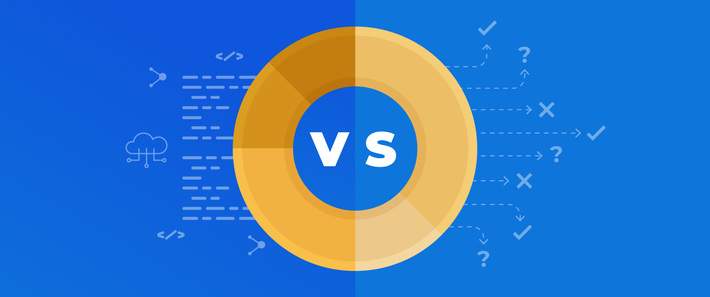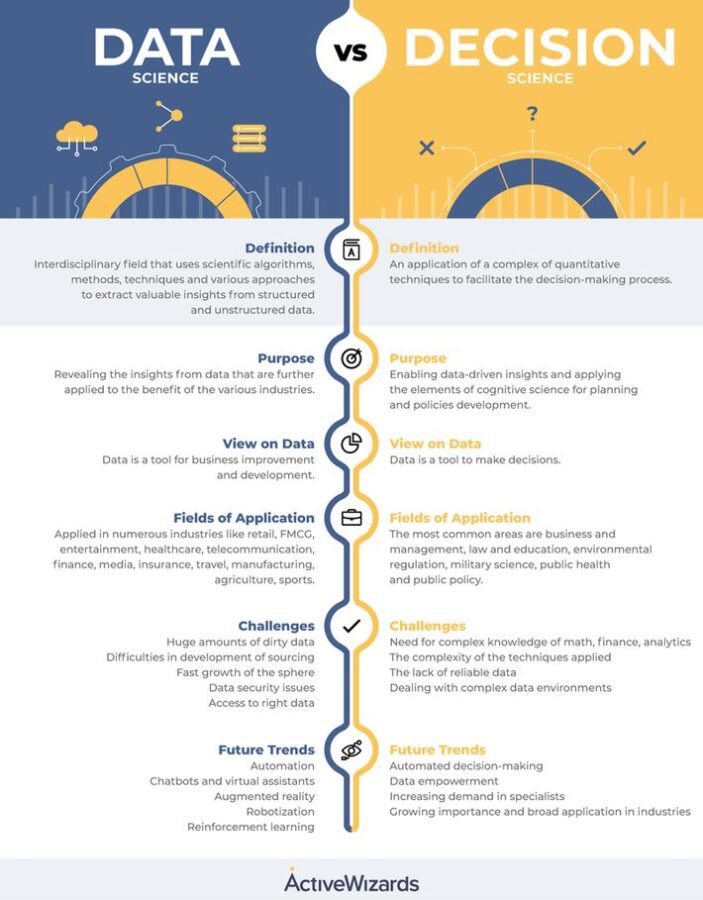
Data science has become a widely used term and a buzzword as well. It is a broad field representing a combination of multiple disciplines. However, there are adjacent areas that deserve proper attention and should not be confused with data science. One of them is decision science. Its importance should not be underestimated, so it is useful to know the actual differences and peculiarities of these two fields. Data science and decision science are related but still separate fields, so at some points, it might be hard to compare them directly.
In general, data scientist is a specialist involved in finding insights from data after this data has been collected, processed, and structured by data engineer. Decision scientist considers data as a tool to make decisions and solve business problems. To demonstrate other differences, we decided to prepare an infographic which puts data science and decision science in contrast according to several criteria. Let’s dive right in.

In terms of definition, data science appears to be an interdisciplinary field that uses scientific algorithms, methods, techniques and various approaches to extract valuable insights. Thus, its primary purpose is to reveal the insights from data for further application to the benefit of the various industries. In contrast, decision science is an application of a complex of quantitative techniques to the decision-making process. Its purpose is to apply the data-driven insights in combination with the elements of cognitive science to policies planning and development. So, data is equally important for both, yet the mechanisms are quite different.
Now, let’s move on to the areas of application. Data science is applied in numerous industries like retail, FMCG, entertainment, media, healthcare, insurance, telecommunication, finance, travel, manufacturing, agriculture, sports, etc. Decision science touches more theoretical areas of business and management, law and education, environmental regulation, military science, public health, and public policy.
Critical challenges the specialists face in these areas also vary. For instance, data scientists struggle with the problems of dirty data, difficulties in sourcing development, security issues, etc. Decisions scientists search for new ways to overcome the lack of reliable data, difficulties caused by complex data environments, and complexity of applied techniques. They should possess knowledge in math, finance, and analytics to make the right decision.
Finally, let’s consider future trends shedding the light on further development and prospects of data science and decision science. According to our expectations, data science will continue its way towards automation, further evolution and extensive use of chatbots and virtual assistants. There will be widespread use of augmented reality elements, further robotization of industries and increasing popularity of reinforcement learning. In contrast, decision science will continue to move us towards automated decision-making and data empowerment. For sure, it is going to achieve vital importance and broad application in industries which will result in increasing demand in specialists.
Conclusion
Data science can be a crucial component of decision science and quite often business owners rely on data science as on a solution to all their problems and worries. However, it is not enough to only use data science. The truth is somewhere in between data science and decision science.
We attempted to show our vision of the commonalities, differences, and specific features of data science and decision science. If you have some ideas or thoughts related to this infographic, feel free to share them for further discussion in the comment section.
